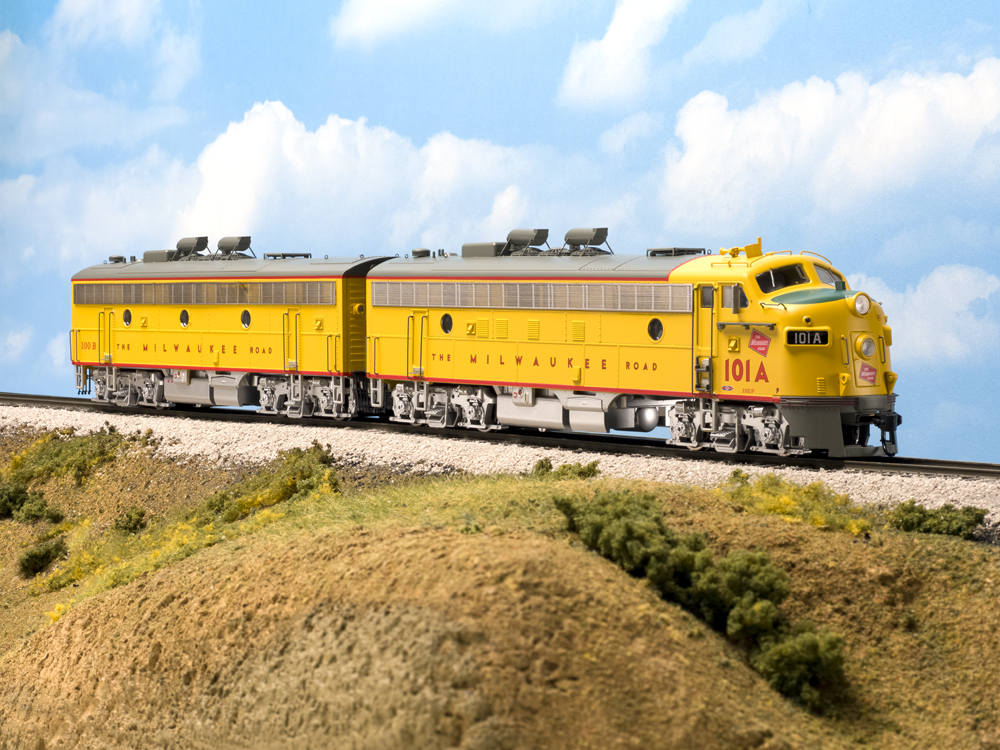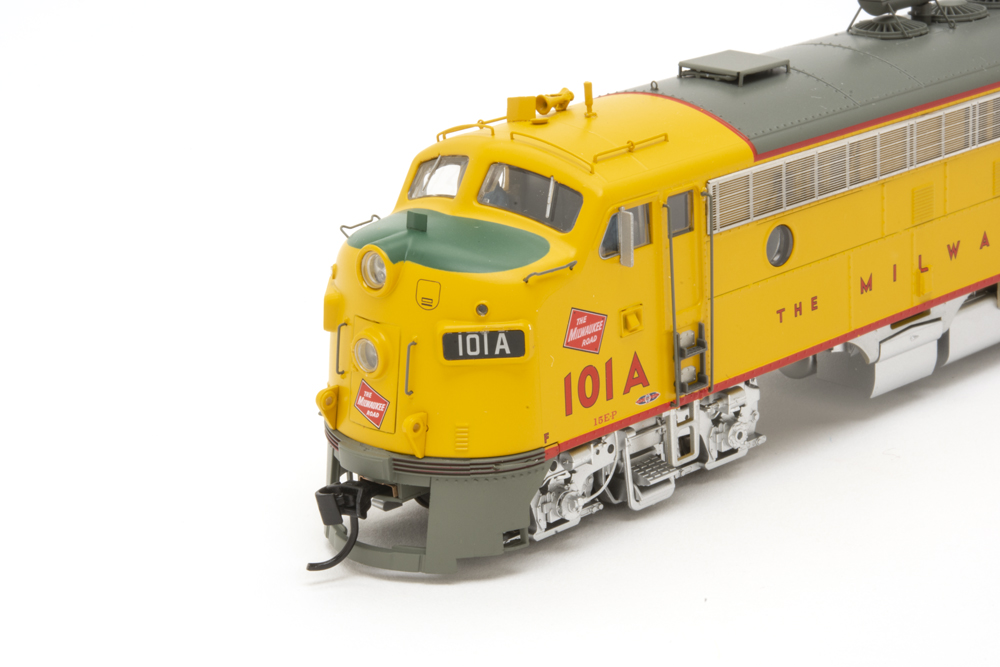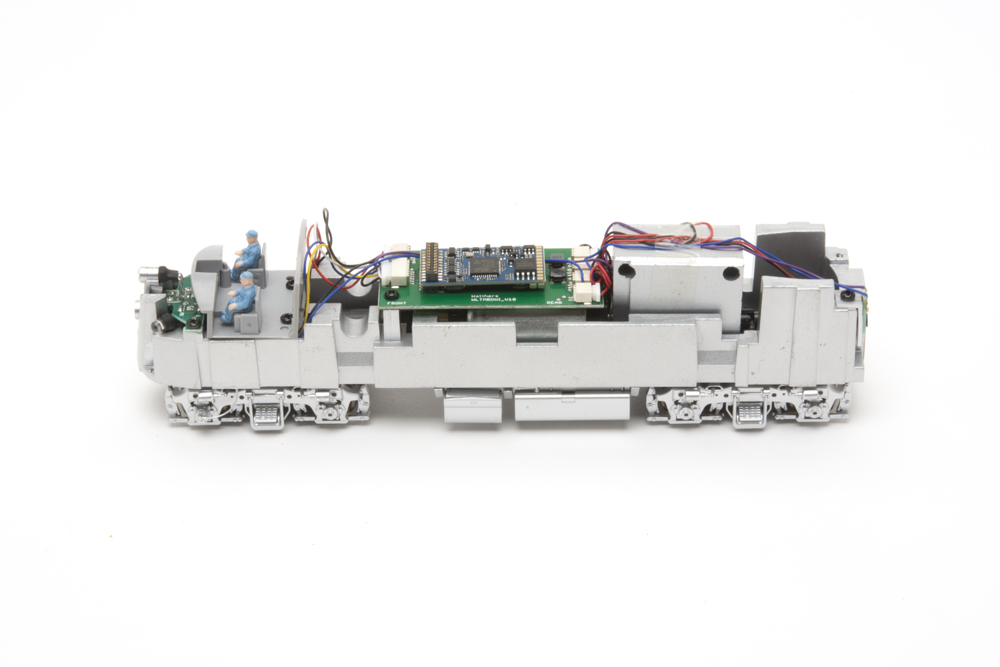
Walthers has reissued its HO scale Electro-Motive Division FP7 and F7B diesel locomotives with new tooling and a LokSound 5 Digital Command Control sound decoder. And wow, is it a brute. The pair of locomotives together mustered almost 2⁄3 of a pound of drawbar pull in our benchwork test and wrestled 30 cars up a curving 3 percent grade on our staff layout. If you’re looking for some nicely detailed transition-era diesels to pull a long passenger train on your layout, Walthers has a set for you. Though most road names are sold out at Walthers’ website, they’re still available at many hobby shops.
Electro-Motive Division’s 1,500hp FP7 was developed to be the best of both worlds. Railroads whose passenger trains traversed mountainous grades found the E series’ A-1-A trucks provided insufficient traction, while F units didn’t have big enough water tanks to supply the steam generators on long trips. Enter the FP7, basically an F7 freight locomotive with 4 extra feet of length for a bigger water tank. Between June 1949 and December 1953, almost 300 were built in EMD’s LaGrange, Ill., plant for American railroads; 57 more were made in London, Ont., for Canadian roads. Mexican railroads received 18 FP7s, and two more went to oil company Saudi Aramco in Saudi Arabia.
No cabless B units of the FP7 were ever made; they were instead sold paired with the F7B booster, like Walthers’ model. Since the F7Bs had no cabs, they had plenty of room for water tanks, so an extended version wasn’t necessary.
Many FP7s remained in service into the Amtrak era of the 1970s. Several are still in working condition today, serving rail museums and excursion railways.
Dimensions and details
I found drawings of the FP7 in The Model Railroader Cyclopedia: Vol. 2, Diesel Locomotives (Kalmbach Books, out of print). I placed the HO scale locomotive on its side directly on top of the drawing, and every feature and dimension lined up. The model also resembled prototype photos published in that book and in The Milwaukee Road Diesel Power by Frederick Hyde and Dale Sanders (The Milwaukee Road Historical Association, 2009).

Our sample set is decorated in the Milwaukee Road’s Union Pacific-inspired Armour Yellow and Harbor Mist Gray scheme, adopted when the Milwaukee began forwarding UP’s City trains from Omaha to Chicago in October 1955. The paint is smooth and even, with sharp color edges between the yellow, gray, and the red lines that separate them. The lettering is crisp and legible, including the thin black outlines on the red lettering.
The model bears numerous prototype-specific details, including a winterization hatch, rooftop oil cooler with cover, and the Milwaukee Road’s unique barrel-style spark arrestors. The eye-catching stainless steel horizontal side grills show air intake detail behind. The handgrabs, sunshades, cab steps, and nose-access toe shelf are painted gray, a nice contrast against the yellow. The silver trucks also have a wealth of separately applied details, like brake cylinders and speed recorders.
Removing the body shell is a simple matter of removing the rear coupler (so as not to damage the delicate uncoupling lever), gently spreading the sides of the shell to disengage the locking tabs, sliding the frame out of the shell, and threading the front coupler through the opening in the pilot. The silver-painted, die-cast metal frame accounts for the model’s weight of more than a pound. The motor and flywheel are nestled in the bottom center and topped with a printed-circuit lighting board and plug-in decoder. Driveshafts connect the motor to the gear towers on each truck. The speaker is solidly enclosed between the motor and the rear gear tower.
Testing, one, two
Our sample models were equipped with dual-mode ESU LokSound DCC decoders, so they can run under either direct current or Digital Command Control (DCC). I tested them first under DCC.
Both engines in the FP7 and F7B set are powered and equipped with sound decoders. I put both of them on the MR workshop’s test track and discovered that they were geared identically, so I did all my testing on the A unit only. The locomotive was programmed with so much momentum that at speed step 1 it merely twitched. This could be corrected by reducing the momentum with an adjustment to Configuration Variable (CV) 23 and/or by increasing the value of Vstart (CV 2). The locomotive rolled steadily on speed step 2 at a stately 1.5 scale mph. On speed step 28, it topped out at 67 scale mph. This is only slightly more than half the prototype’s rated top speed of 118 mph, but it’s probably plenty fast for most model railroads.

I checked out all the sounds and light controls available on the throttles’ function keys. The bell (function key 1) and horn (F2) sounded great. Function key 3 played a coupler crash and F4 dynamic brakes. I liked that the headlights (F0), Mars light (F5), and lighted number boxes (F6) could all be turned on and off separately.
Under direct current, the only sounds that played were the diesel engine rumble and a brake squeal when the speed was sharply reduced. Sounds came on at 8.5 volts, and at 10V, the locomotive rolled at 2.5 scale mph. At 14V, the peak output of the Atlas power pack I used, it moved at 85 scale mph, which was faster than the top speed in DCC, but still slower than the prototype.
The locomotives’ pulling power floored me. When I hooked the A unit to our workbench force meter, I actually had to hold the instrument down lest the engine drag it down the track. It registered more than 1⁄3 of a pound of drawbar pull – enough to haul 80 40-foot freight cars or 40 passenger cars on straight and level track. The B unit was even stronger.
Using our workshop’s NCE PowerCab DCC system, I was easily able to set up a consist with both engines. The FP7 and F7B were well speed-matched right out of the box. Coupled together, the two mustered almost 2⁄3 of a pound of force.
I then took the consisted locomotives to our Milwaukee, Racine & Troy staff layout and coupled them to a string of 20 assorted 50- to 60-foot freight cars in the Bay Junction yard. I notched up the throttle and the train summited the curving 3 percent grade to Skyridge without a hiccup. I tacked on more and more until the wheels slipped at 35 cars. Thirty was about the limit. You don’t have to worry that your passenger train is too long for these locomotives.
A home run
Walthers has hit it out of the park again. The upgraded body tooling is attractive and accurate, the drivetrain is smooth and responsive, and the LokSound 5 decoder’s sounds are strong and vibrant. This is a locomotive set that deserves to be at the head of your railroad’s crack passenger streamliner.
Facts & features
Price: FP7 and F7B set: with LokSound 5 DCC and sound, $549.98; DC no sound, $369.98. FP7 only: DCC sound, $279.98; DC, $189.98.
Manufacturer
Wm. K. Walthers Inc.
5601 W. Florist Ave.
Milwaukee, WI 53218 walthers.com
Era: 1949-1970s (some remain in service on excursion railroads today)
Road names: Milwaukee Road (Armour Yellow and Harbor Mist Gray and modified orange and maroon), Amtrak (pointless arrow), Pennsylvania RR (“Brunswick Green” single stripe scheme), Soo Line (maroon and Dulux Gold), Southern Pacific (“bloody nose” scheme), and Southern Ry. (“tuxedo” scheme).
Features
– Blackened-metal RP-25 contour wheels, in gauge
– Cab interior with engineer and fireman figures
– Directional light-emitting-diode headlight and backup light
– ESU LokSound 5 Digital Command Control sound decoder (available)
– Etched-metal grills, windshield wipers, lift rings, and other details
– Five-pole, skew-wound motors with flywheels
– Lighted number boxes (A unit only)
– New body tooling
– Proto-max metal knuckle couplers, at correct height
– Prototype-specific details
– Weight: 1 lb., 2.2 ounces (FP7); 1 lb., 1.6 ounces (F7B)
– Wire grab irons
– Working Mars light (A unit only)














Great product and I would love to have lt. But this is one of the reasons this retired hogger doesn’t practice MRing: too expensive.
I will stick to fly fishing which is also pricey.
If you can afford these quality locomotives, you should buy them!